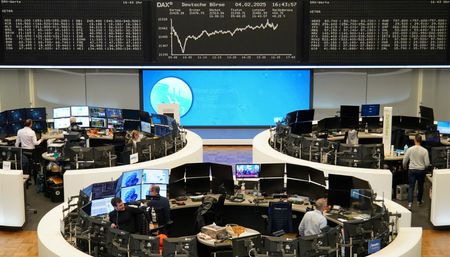By Danilo Masoni
MILAN (Reuters) – European stocks have staged their best performance in a decade against Wall Street in the first six weeks of 2025, but hopes among some they can finally end years of underperformance could yet be dashed by long-standing structural challenges.
Seizing on extreme company valuation gaps, investors are piling into European equities, eyeing several potential catalysts that might mean this rally is different from those before, which have typically fizzled fairly quickly.
Fund inflows into European stocks reached their second-highest in 25 years in January and major benchmarks continue to hit record highs, beating their U.S. counterparts, as investors look for the region’s stars to finally align.
The hope is that Germany might loosen its fiscal policy after elections this month, tensions in Ukraine could subside and U.S. tariffs might end up being less severe than feared.
And the recent rout in stocks of Wall Street’s artificial intelligence megacaps on the emergence of cheaper Chinese rivals suggests market leadership could expand to neglected sectors, in which Europe is particularly strong.
Gains in Frankfurt, Zurich, London, Milan and Paris so far this year have propelled the broader STOXX 600 up by more than 5.5%, while the S&P 500 has risen only 2.7%.
LEG UP
Marc Halperin, portfolio manager at Edmond de Rothschild AM, is upbeat, especially given the stretched investor positioning.
“Where is the marginal seller? It’s hard to find because everyone is today largely underweight on Europe,” said Halperin, who in December increased his euro zone cyclical stock holdings.
Halperin anticipates a rebound in leading indicators, potential interest rate cuts from the European Central Bank and the U.S. Federal Reserve pausing, as well as a possible Ukraine ceasefire reducing energy costs.
“Europe is focused on sectors like automotive, which have significant room to grow because they are depressed. This strong performance seen since the start of the year could last a little more in the weeks and months to come,” he added.
Research firm SentimenTrader notes that several technical metrics that reflect how broad a rally is – such as the 10-day advance/decline ratio and stocks that are trading above their 50-day moving averages – have spiked.
This draws a pattern that historically has preceded a period of gains over the next one to three months, it said.
Nordea strategist Hertta Alava, meanwhile, also anticipates further outperformance in the coming months as valuations are attractive and earnings growth is accelerating, which will narrow the gap with U.S. companies.
At 14 times expected earnings, the MSCI Europe trades at a near record discount of 37.5% to the MSCI USA, LSEG data shows.
Since the late 1980s, U.S. stocks have increased by 25 times, while European stocks have risen by less than six.
However, any further surge is unlikely to truly challenge Wall Street’s long-term dominance. Europe has seen occasional rallies over the past 40 years, but these have tended to be short-lived, especially after the global financial crisis.
Michele Morganti, strategist at Generali Investments, also notes lower growth in U.S. tech earnings and possible bolder China stimulus measures might allow for a shift towards Europe.
But structural challenges remain, he said, adding: “Europe still faces issues, such as less energy independence, poor governance … fragmented energy and capital markets, lower population growth, and lower tech investments”.
European earnings growth this year is expected to accelerate significantly, to 7.9% from just 1% last year and following a 3.9% decline in 2023, LSEG IBES forecast show.
In contrast, while U.S. earnings growth is expected to increase at a slower rate this year, it is still anticipated to be higher than Europe’s, at 14.1%, from over 10% last year
(Reporting by Danilo Masoni; Editing by Amanda Cooper and Alexander Smith)








